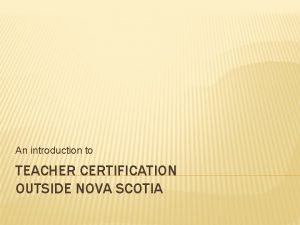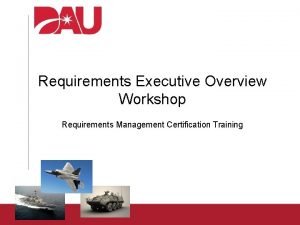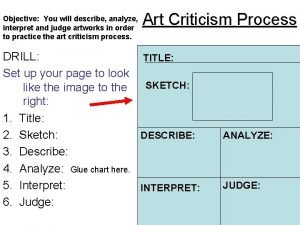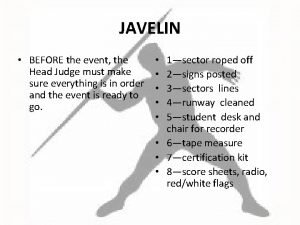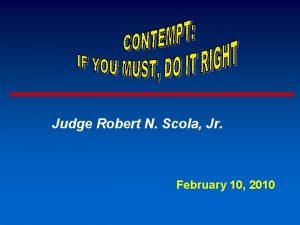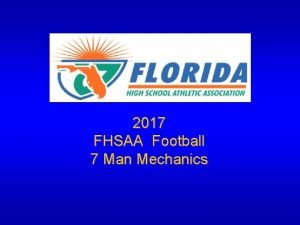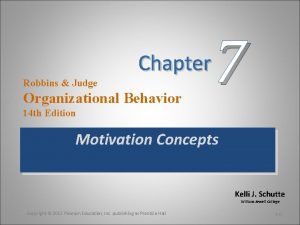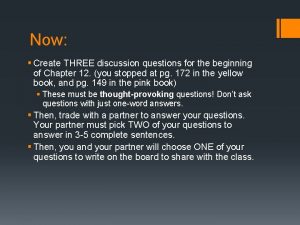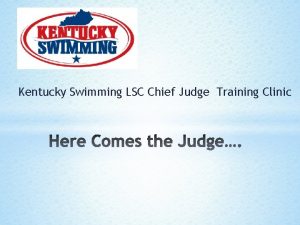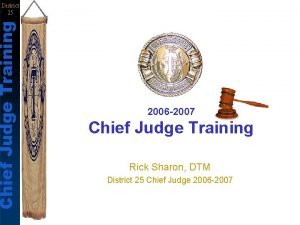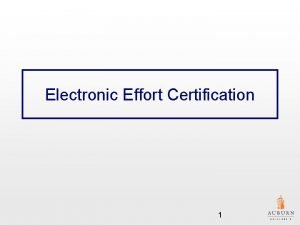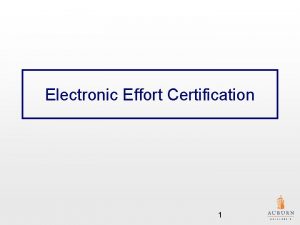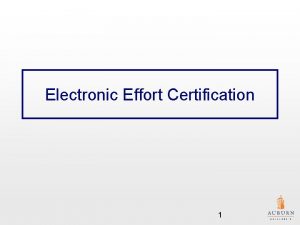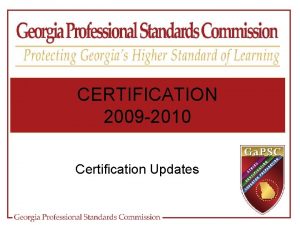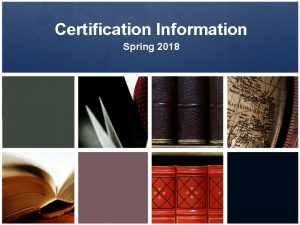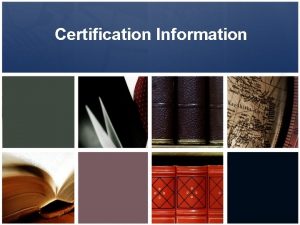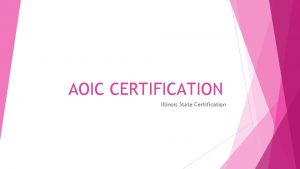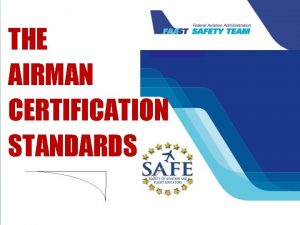Chief Judge Certification Clinic Chief Judge Certification Requirements




















- Slides: 20

Chief Judge Certification Clinic

Chief Judge Certification Requirements • Initial Education & Training • USA-S Membership: Required. • Previous Certifications: Certified as a Stroke & Turn Judge for a minimum of one year, with satisfactory performance during that time. • Clinic: VSI-approved training clinic required.

Chief Judge Certification Requirements (cont) • On-the-Job Training & Initial Certification • Complete a minimum of four sessions of training at VSI-sanctioned swim meets with positive recommendations from the Trainer and Meet Referee. • Individuals currently certified as Referees may certify by attending a training clinic. • The District Officials Chairperson will issue a certification card upon the satisfactory completion of all the training requirements.

Chief Judge Re-Certification Requirements • Recertification • Work a minimum of two sessions during the previous year. • Based on continuing USA Swimming membership and satisfactory performance.



Chief Judge Responsibilities • The Chief Judge is the stroke and turn officials’ mentor. This person is one of the keys to the smooth running of a swim meet. The chief judge position may be combined with another stroke and turn assignment if necessary. • The chief judge is responsible to the meet referee and the assistant referees. The Team Lead Chief Judge is the deck officials’ representation of the meet referee.

The Chief Judge • At national meets there is one team lead chief judge with four assistant chief judges. The team lead chief judge is usually stationed in the starting area to assist the deck referees with any no-shows and declared false starts that need to be recorded. The remaining four judges are stationed around the pool to watch the officials in their quadrants. At local meets, two chief judges, one at each end of the pool, are recommended for any large invitational meet and at 50 -meter pools.

Pre-Meet • Meet with the meet referee to coordinate all duties the chief judge will be expected to perform. • Solidify the terminology the meet referee expects during the meet. Attend the assigned officials meeting and make sure of the jurisdiction and protocol the referees expect from the officials. • Ask if the referee wants the officials to parade into the finals sessions and if the announcer needs any specific information on the officials working the meet, (ex: hometown, years of volunteering to USA swimming). • Also ask where the staging of the awards will take place and agree on how or where the officials should move to if needed. Make sure you send a letter to each of your chief judges welcoming them to your crew and give them a head-up of what the meet is about.

Pre-Meet (cont) • If you do not know any of the chief judges assigned to you ask if any of them have worked this position before. Let them know when you expect to meet with them for pre-meet assignments. This is the meeting where you go over the information the referee and you have discussed. Review the letter you have sent to them to make sure they have no questions about their duties during the meet. • At this meeting time it is a good suggestion to have already done the first day’s assignment and give copies to each of your crew. • Make sure the officials are rotated around the deck and explain how they will accomplish this. As the assignments are done the day before each session, post them so the officials will know ahead of time their schedule for the next day.

Pre-Meet Sessions: Conducting The Officials’ Meetings • The chief judge is responsible for the officials’ sign-in-sheets, introductions, and assignments of officials for deck coverage, deck protocol, jurisdiction, communication and radio etiquette. • The chief judges should establish a rotation system and arrange relief shift if possible. The chief judges will conduct stroke miniclinics and answer officials’ concerns before each session. The team lead, with the Vice-President of Operations and/or the Officials’ Chair schedules speakers for the group during the course of the meet if it is a National Championship Meet. • The chief judges also make sure all officials’ equipment and supplies are working and in the right places. Included in the appendix to the Swimming Officials Manual is a “Recommended Stroke Briefing” outline. Make sure you have the latest version. This outline is also on the USA website. • If the meet is a camera ready meet you will not have timers. You will not need to be concerned about staffing this position nor the supplies that are needed for this job. Below is listed the deck equipment needed for your meetings and the meet.

Chief Judge Checklist • Equipment and Forms from Facility Personnel / USA Swimming Website • Bells/Lap Counters, Split Sheets for Distance Events, Towels (to wipe chairs off) • Pencils, Relay Take-Off Slips, Chairs • Heat Sheets, Officials Sign-In Sheets, Refreshments • Two-way Radios w/Headsets , Spare Batteries, Jurisdiction Document • Assignment Form, Stroke Information, Timers Recording Sheets • DQ Slips, No-Show Slips, IRS letter from Meet Referee • Certification Evaluation Forms, *Clipboards *Watches – *Clipboards and watches are not needed for a meet using cameras as back-up timing.

During Competition • The chief judges are placed inconspicuously at the pool corners. During the free-style events they may be seated as long as they can still view their officials watching the turns. • The chief judge’s focus is on the officials in his or her quadrant. When noticing an infraction, the official shall raise a hand immediately or make eye contact (for FINA protocol meet) immediately to the chief judge. The chief judge alerts the deck referee by two-way radio of a possible disqualification and at what position the infraction occurred, (e. g. “possible disqualification, stroke judge lane 1 or 8 side” or “possible disqualification, lane X start/turn end”). The team lead shall insure continued deck coverage during the discussion of the disqualification. The chief judge will approach that official and ask: What did you see? What is the rule? What is your jurisdiction? • After the chief judge hears the answers from the official, the infraction is reported to the referee using correct terminology. The Radio Etiquette and Protocol guidelines are available on the officials section of the USA Swimming website.

During Competition (cont) • The chief judge then should recommend to the referee that they accept if all information is correct or not to accept the disqualification from the official if something was wrong with the information or jurisdiction. It is then the responsibility of the chief judge at the finish end of the pool to notify the swimmer if the disqualification stands. It is recommended that the chief judge call the swimmer to a position behind the seated officials to notify him/her of the disqualification. • It is also the chief judges’ responsibility to notify the swimmers that if they do not agree with the infraction their coach has a right to talk with the referee about the call that was made. • The decision to accept or reject a disqualification is the responsibility of the referee. When the decision to accept has been made the chief judge fills out the disqualification slip and verifies all the information is correct, has that official sign the disqualification form and then turns over the slip to the referee. If a slip is filled out at the turn end of the pool, use the stroke judges as couriers to turn the slip into the referee on duty. • In the event there is a false start the team lead chief judge or the chief judge assigned at the starting area corner will notify the swimmer of the infraction.

During Competition (cont) • If an official needs to be excused for any reason, the chief judges have the responsibility to maintain equal coverage on the deck at all times and may assign relief officials to the vacant position or may assume the vacant position themselves if necessary. Sometimes other officials (i. e. the off duty starters or deck referees) are asked to fill these positions if possible.

During Competition (cont) • During relays, the chief judges are assigned to look for dual confirmation of an early take-off from the side and lane judges by comparing both the ballot slips from each lane and the ballot slip from the side official covering the same lane. If an official on the side has marked his/her ballot, the chief judge states possible disqualification lanes 1 -4 or 5 -8 and immediately goes to the furthest part of his/her quadrant and gathers all the ballots. As soon as he/she sees there is a confirmation, the chief judge states confirmation lane number or if there is no confirmation, the chief judge states “all clear lanes 1 -4 or 5 -8” so the referee knows there is or is not a disqualification. If there is a confirmation, the relay takeoff slips must be turned over to the referee as well as the completed DQ slip. It is important to tell the team that has been disqualified which exchange it was, (e. g. 2 nd swimmer or 1 st exchange).

Post Meet Duties • It is very important that the chief judges thank every official appropriately for the generous contribution of their time to the meet. • Chief Judges are often asked to evaluate the performance of the stroke and turn judges. Their observations include the protocol established for the meet, as well as the technical aspects of judging. This is meant to be educational! It is meant to point out where improvement in certain areas will help the stroke and turn judge become more knowledgeable and continue to improve, as everyone of the officials’ crew should always be trying to do their best for the athletes.

Post Meet Duties (cont) • If there is a need to talk with an official about suggestions for improvement this is to be done in a constructive manner not to embarrass or berate, but rather to educate. If this cannot be done while at the site, then choose to do it soon after the meet, but not by an e-mail. A phone call or letter would be appropriate with a copy to the Officials Chair. • The team lead needs to make sure he/she has input from his/her chief judges and especially note the excellent qualities of the exceptional official for recommendation to the Officials’ Chair. The team lead needs to evaluate his/her team of chief judges and send that report in to the Officials Chair as well. It is also important for the team lead to submit an overall view of the chief judges and officials to the meet referee in a very timely manor so he/she can complete his/her report.

Evaluations • All evaluations will be sent to the Officials’ Chair and a copy for your records for one year. This becomes important when the Vice President of Program Operations and the Officials Chair are looking for upgrading officials and need more information on particular officials that worked your meet. It is important to be fair and educational in evaluating all stroke and turn officials.

Summary • There are many meets where there are not an adequate number of officials. In the case where there are only four stroke and turn judges in addition to the starter and referee, two of them could be made a chief judge and two can be the stroke judges. • There is almost always a way to use chief judges to implement the paper work of critiquing strokes. However, when there is a real shortage of officials, it is imperative that the radios be used to expedite the flow of the meet. • The idea that a chief judge is only for championship meets is simply not true. An advantage of using this position whenever possible is that it becomes a teaching tool or mentoring opportunity for anyone that fills this position and can assist the other deck officials.
 Chapter 9 lesson 3 commander in chief and chief diplomat
Chapter 9 lesson 3 commander in chief and chief diplomat Acf certification
Acf certification What is cfre
What is cfre Nova scotia teaching certificate
Nova scotia teaching certificate Defense requirements management training
Defense requirements management training Cpn past questions
Cpn past questions Cic certification exam
Cic certification exam Describe identify interpret judge
Describe identify interpret judge Javelin tow
Javelin tow Fatsly
Fatsly Judge robert scola
Judge robert scola John proctor quotes the crucible
John proctor quotes the crucible For adult
For adult Immfa
Immfa District judge etherington
District judge etherington Jury vs judge
Jury vs judge Back judge 5 man mechanics
Back judge 5 man mechanics Robbins and judge
Robbins and judge Round vs flat character
Round vs flat character Franklin county environmental court
Franklin county environmental court See judge act worksheet
See judge act worksheet



